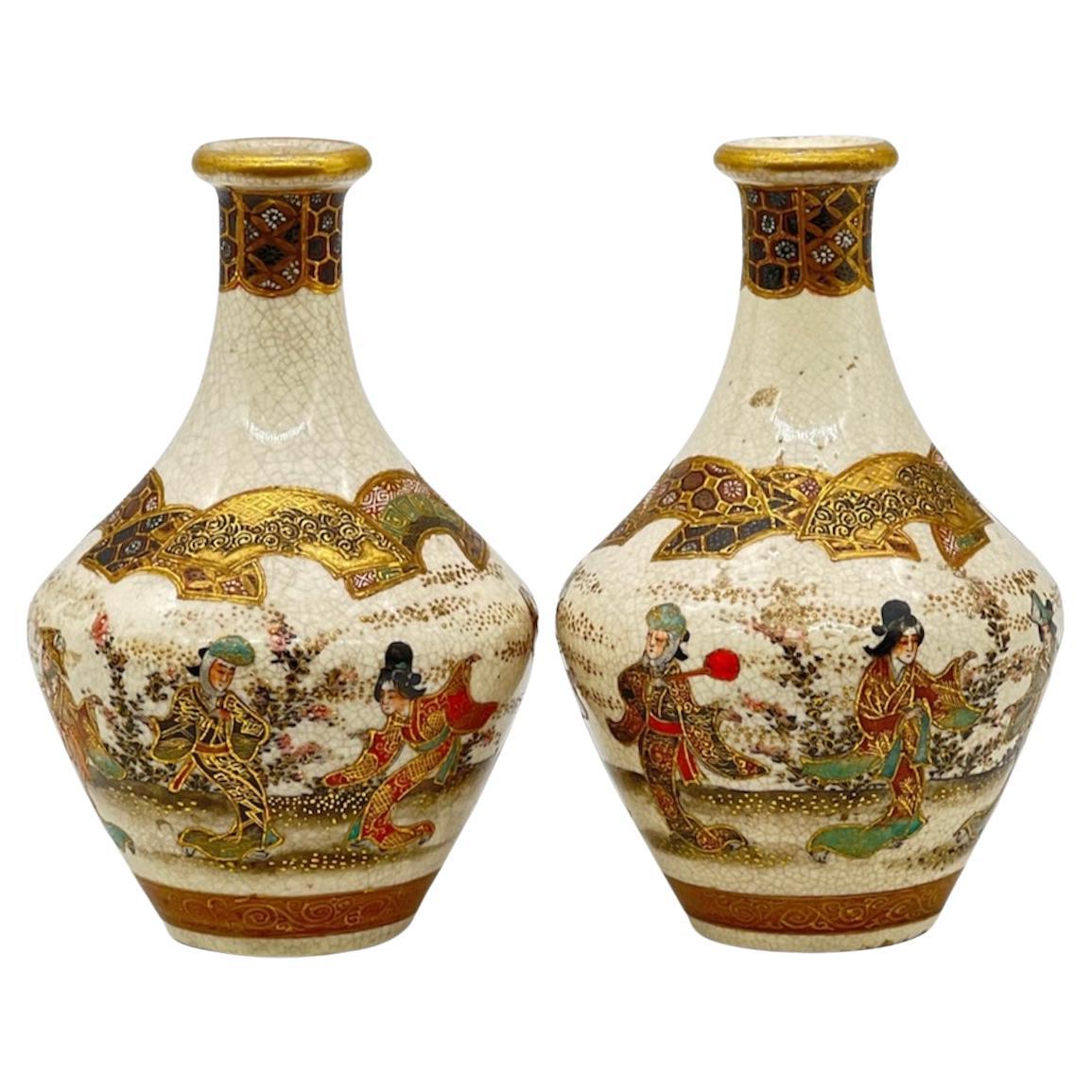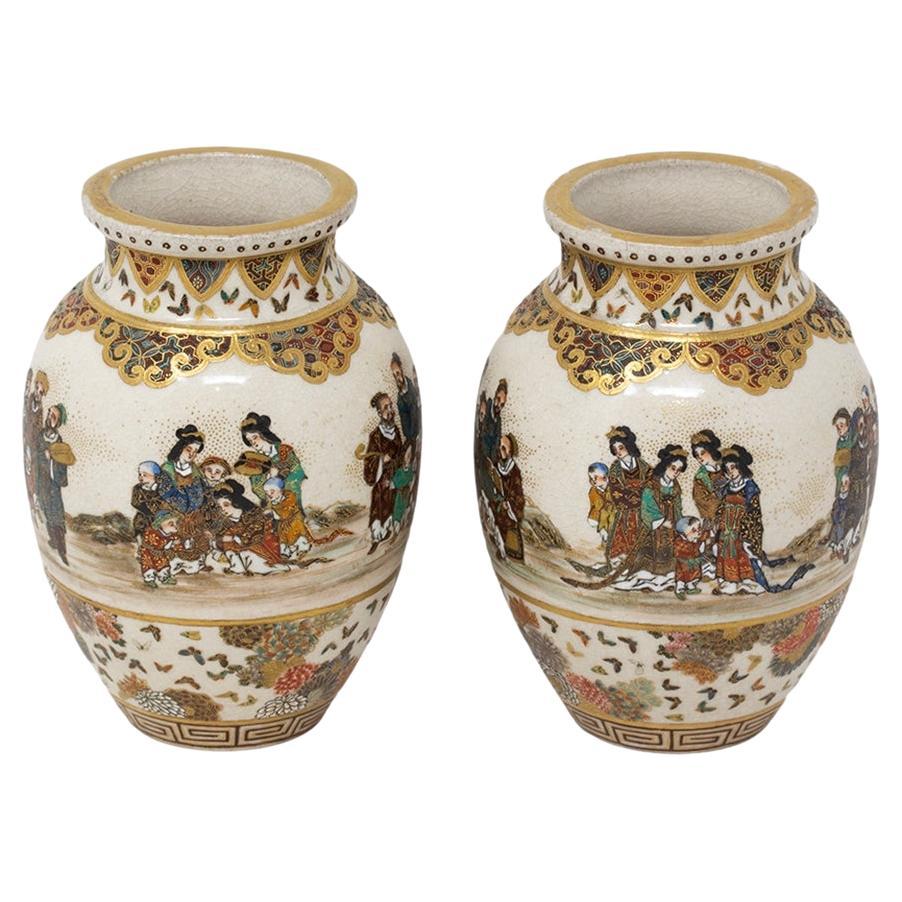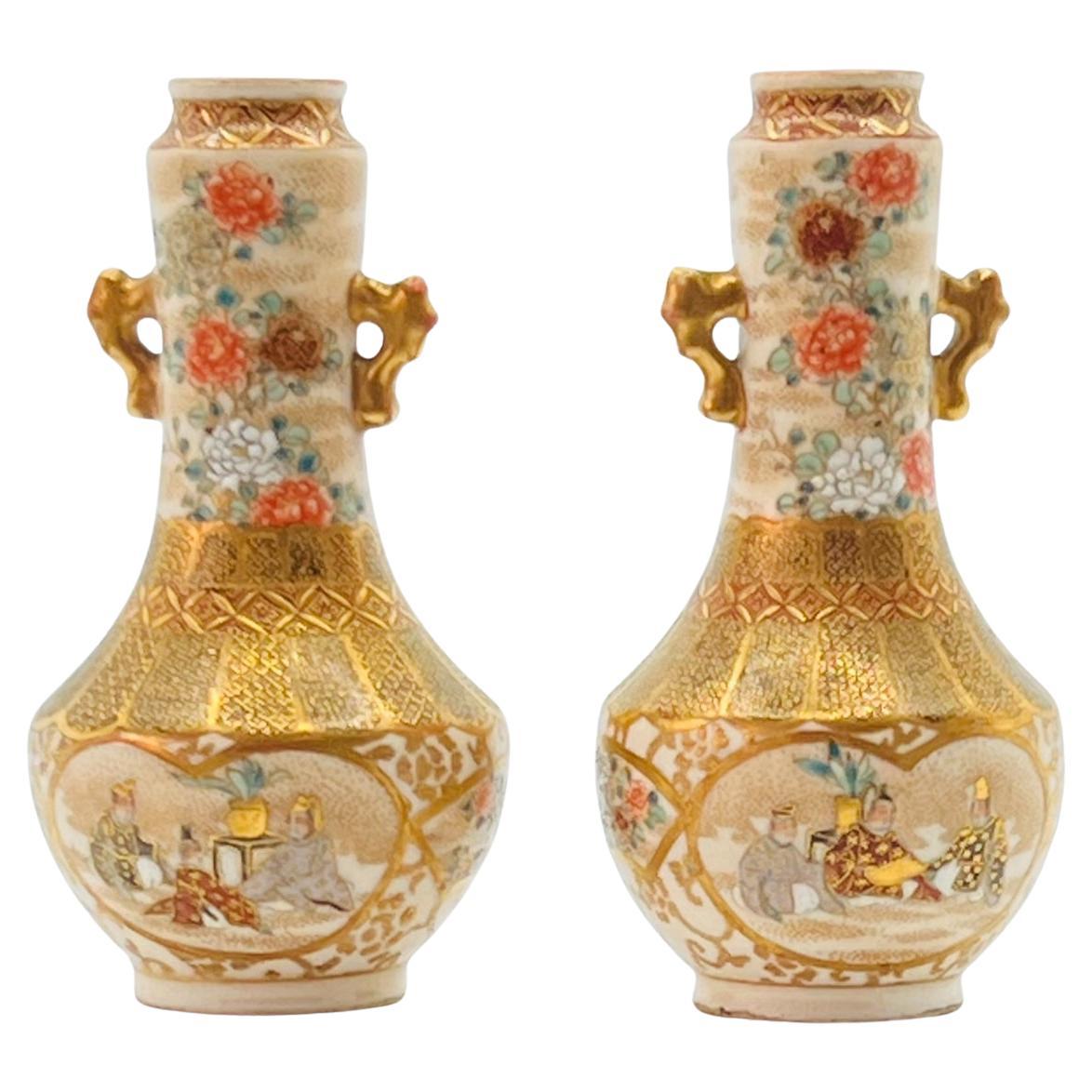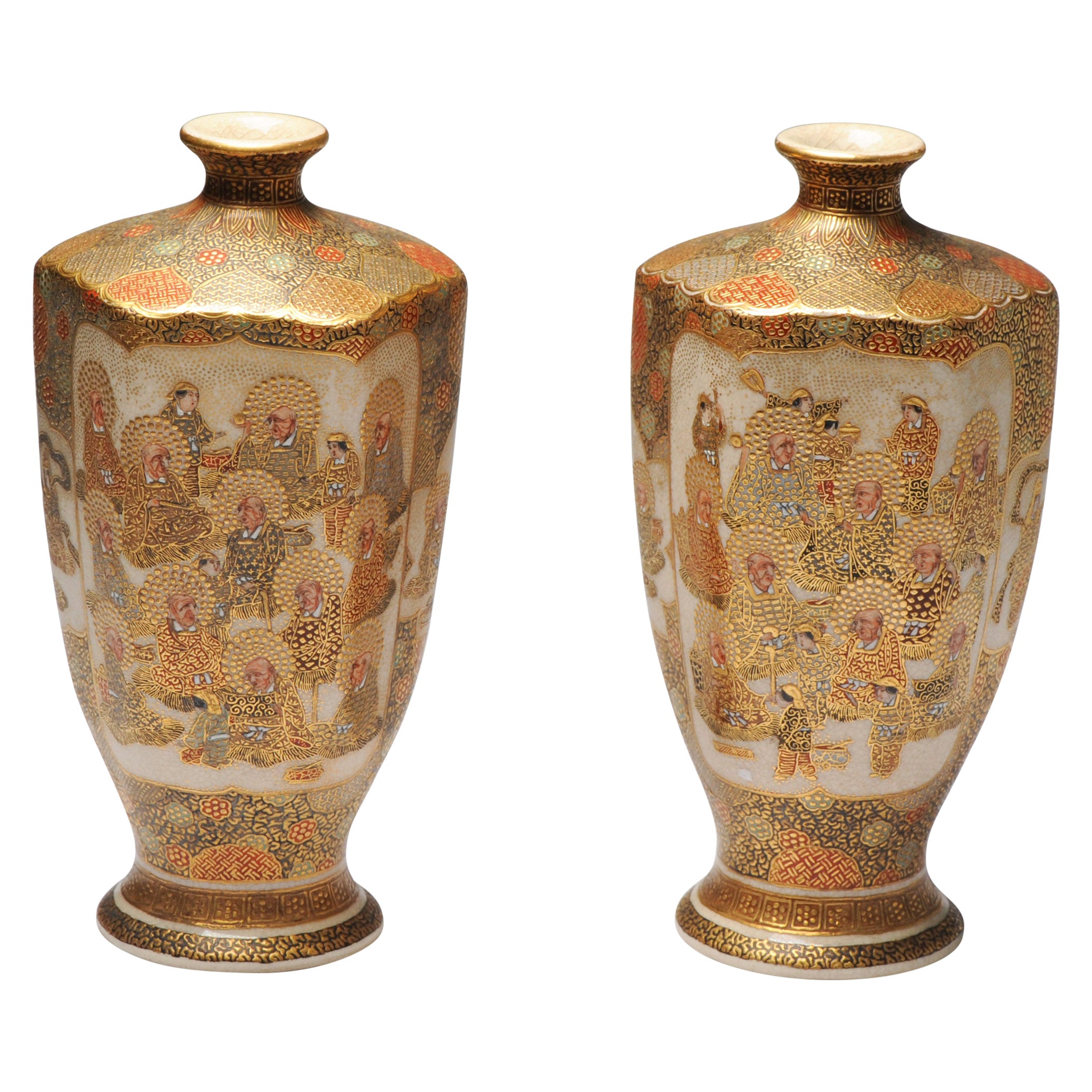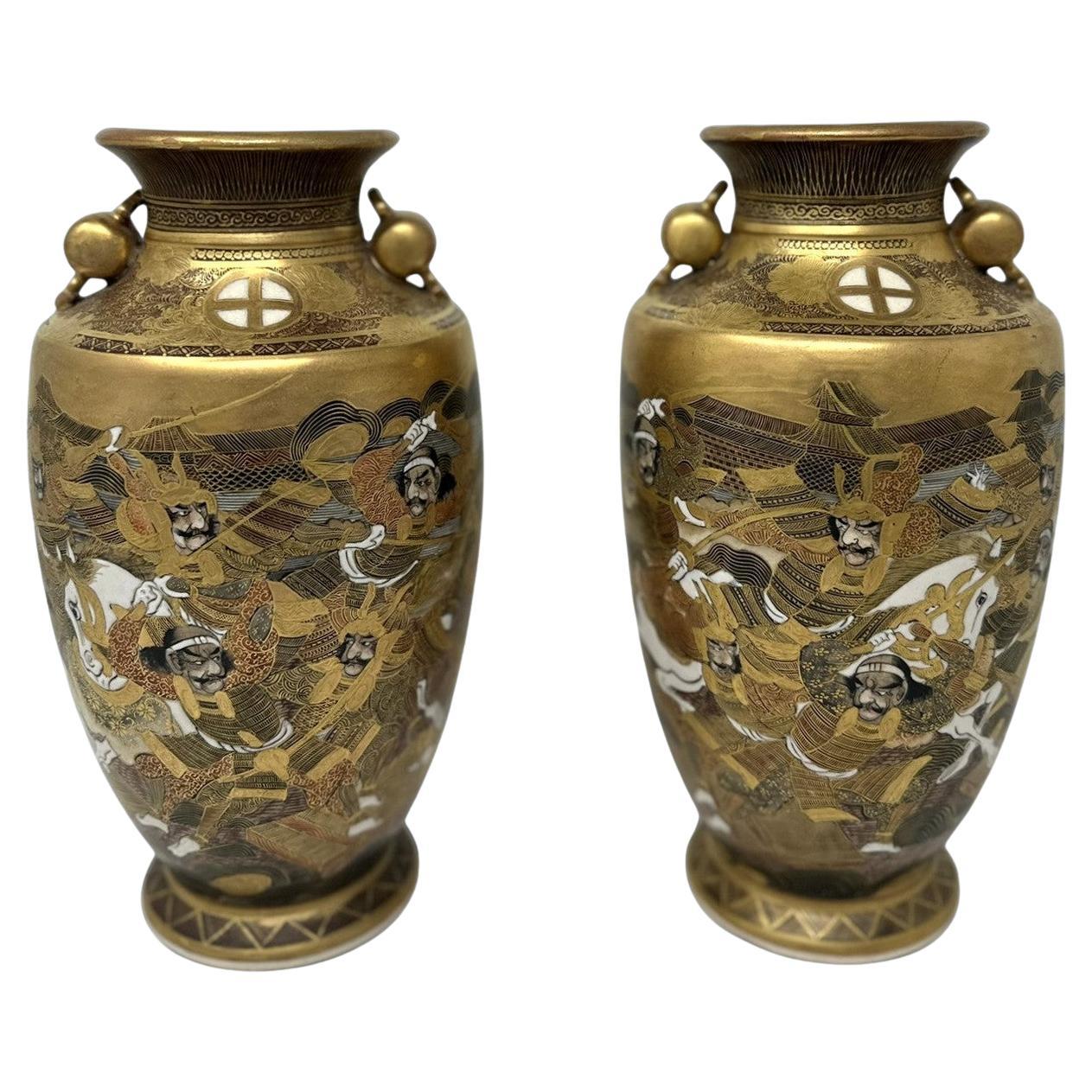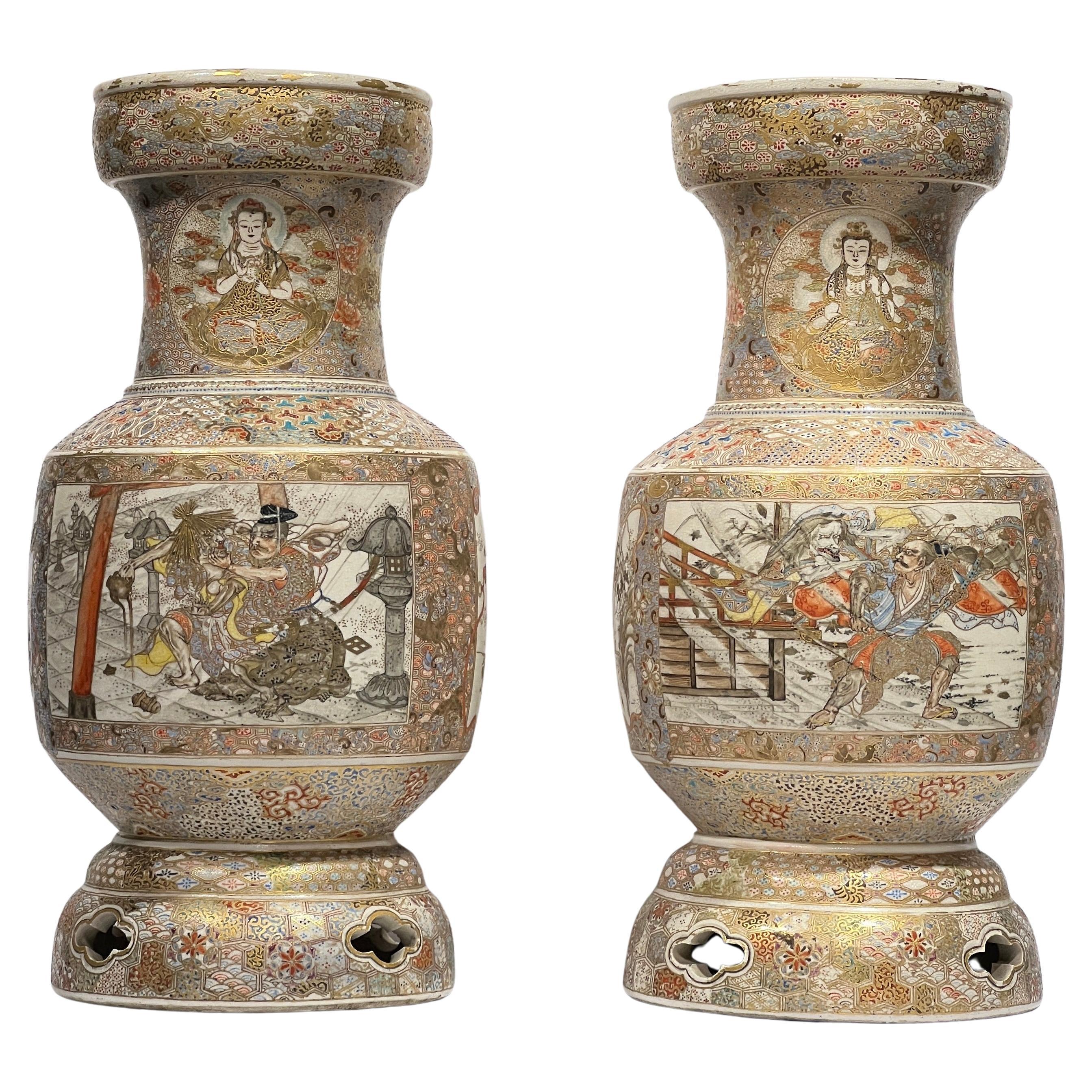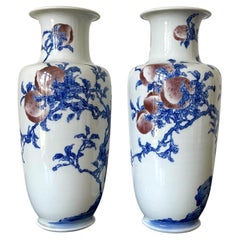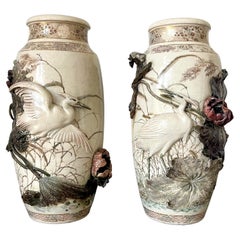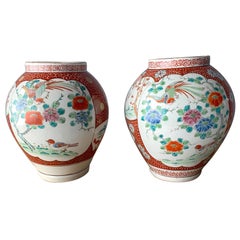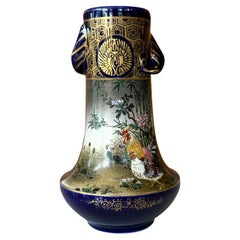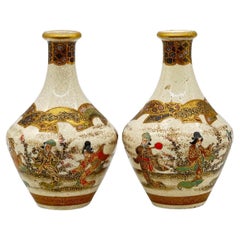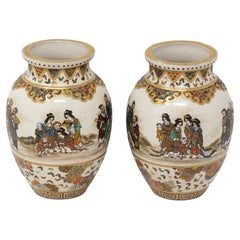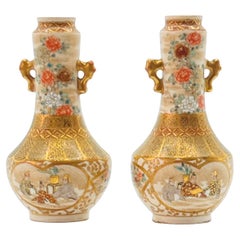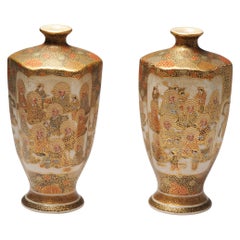Items Similar to Pair of Fine Miniature Satsuma Vase with Moriage Enamel Decoration by Seikozan
Want more images or videos?
Request additional images or videos from the seller
1 of 21
Pair of Fine Miniature Satsuma Vase with Moriage Enamel Decoration by Seikozan
$16,000per set
£12,019.65per set
€13,860.61per set
CA$22,202.09per set
A$24,671.42per set
CHF 12,928.08per set
MX$302,550.95per set
NOK 164,890.18per set
SEK 155,122.63per set
DKK 103,449.69per set
Shipping
Retrieving quote...The 1stDibs Promise:
Authenticity Guarantee,
Money-Back Guarantee,
24-Hour Cancellation
About the Item
A pair of small ceramic vases with superb surface decorations made by Japanese studio Seikozan circa 1890-1910s (late Meiji Period). One of the many artist studios that specialized in satsuma ware, Seikozan was perhaps a handful exceptional establishment in Kobe that produced masterpieces with the highest quality and craftmanship, comparable to the work from the studio of Yabu Meizan. The output was small and most limited to miniature scale with impeccably detailed surface decoration.
The matching satsuma vases form a rare pair, and they feature dense gilt and enamel decoration in a slight moriage fashion. Each vase features two shield-shape vignettes at front and back, surrounded by gilt borders, and in between, partitioned zones of various geometrical and floral motifs in jewel-tone enamels. Each vignette depicts a boisterous scene from various stage of a festival gathering, populated by large numbers of party goers. From the preparing the initial arrival of the guests to welcome the guests at the gate, from arranging foods and drinks to the final lively banquet. The four vignettes form a continuous story board. Densely painted as it was, every character was rendered lively and completely unique, from their attires, postures, gestures, movements, down to the facial expressions, and all ages and genders were included. The dimensional composition and meticulous execution are so impressive that the images impress the viewers as a snapshot of the moment. One can feel the infection of the joyful atmosphere by looking at them.
Both vases were signed on the base "Seikozan". These are miniature masterpieces, pinnacle in workmanship and rarely available as a pair with spatial and temporal pictorial narratives.
- Dimensions:Height: 5.3 in (13.47 cm)Diameter: 3.5 in (8.89 cm)
- Sold As:Set of 2
- Style:Meiji (Of the Period)
- Materials and Techniques:Ceramic,Enameled
- Place of Origin:
- Period:
- Date of Manufacture:1890-1910s
- Condition:Wear consistent with age and use. Fine antique condition with minor shelf wear and very light gilt rubbing around the mouth rim.
- Seller Location:Atlanta, GA
- Reference Number:1stDibs: LU945038418892
About the Seller
4.9
Platinum Seller
Premium sellers with a 4.7+ rating and 24-hour response times
Established in 2006
1stDibs seller since 2010
564 sales on 1stDibs
Typical response time: <1 hour
- ShippingRetrieving quote...Shipping from: Atlanta, GA
- Return Policy
Authenticity Guarantee
In the unlikely event there’s an issue with an item’s authenticity, contact us within 1 year for a full refund. DetailsMoney-Back Guarantee
If your item is not as described, is damaged in transit, or does not arrive, contact us within 7 days for a full refund. Details24-Hour Cancellation
You have a 24-hour grace period in which to reconsider your purchase, with no questions asked.Vetted Professional Sellers
Our world-class sellers must adhere to strict standards for service and quality, maintaining the integrity of our listings.Price-Match Guarantee
If you find that a seller listed the same item for a lower price elsewhere, we’ll match it.Trusted Global Delivery
Our best-in-class carrier network provides specialized shipping options worldwide, including custom delivery.More From This Seller
View AllPair of Rare Porcelain Commemorative Vases by Makuzu Kozan Meiji Period
By Makuzu Kozan
Located in Atlanta, GA
A pair of porcelain vases in classic form, decorated with underglaze blue and copper red painting by Imperial potter Makuzu Kozan. Also known as Miyagawa Kozan (1842–1916), Makuzu was one of the most established and collected ceramist known to the west from Meiji Period.
The vases are in a classic Chinese form called "Bang Chu Ping" (grain-mallet vase...
Category
Vintage 1910s Japanese Japonisme Ceramics
Materials
Ceramic
Rare Pair of Early Period Makuzu Kozan Takauki High-Relief Vases
By Makuzu Kozan
Located in Atlanta, GA
A stunning pair of ceramic vases with gilt, paint and high-relief decoration by imperial artist Makuzu Kozan (1842-1916, also known as Miyagawa Kozan) circa 1876-81 (late Meiji period). These vases belong to early period (1876-1881) of Kozan's repertoire, during which time the high relief sculpturing (known as Takauki ware) was used as a distinguished technique on top of the traditional gilt and paint ornaments of satsuma ware. Due to the relatively limited production and the fragile nature of these wares, not a large quantity of the examples remained in the first place, not mentioning a fine matching signed pair in such impressive sizes.
Not only a rarity, this pair of vases is also superb in workmanship, thus the fine example of the work from that short and unique period of the artist's career before he switched to the underglaze period. In a conceptually mirrored fashion, the surface is richly decorated with flying cranes among large lotus leaves and flower, like an idyllic aqua scenery of pure poetry on a circular scroll. The high-relief appliques were rendered and composed in realistic fashion but with a dramatic touch. They are literally about to break the surface free, alive and in motion. The dark colors of the glaze were used to set a moody tone. The approach to create this type of ornamentations is more akin to sculpturing an ink painting in three-dimension than ceramic making. It is not hard to imagine the demand of both the artistry and the technique.
Both vases were signed as "Makuzu Kozan Kiln" and each further with another name and seal, which are most likely the individual artist involved in the making process. Similar signatures can be seen in the reference book below.
For similarly Takauki vases, see Miyagawa Kozan Makuzu...
Category
Antique 1870s Japanese Japonisme Ceramics
Materials
Ceramic
Near Pair of Antique Japanese Arita Export Ceramic Jars
Located in Atlanta, GA
A near pair Hizen pottery jars from Artia Japan, circa mid-19th century of the Meiji Era. Heavy stoneware construction with overglaze enamels that was inspired by Chinese WuCai from ...
Category
Antique Mid-19th Century Japanese Japonisme Ceramics
Materials
Ceramic
Fine Japanese Ceramic Satsuma Vase by Kinkozan
By Kinkozan
Located in Atlanta, GA
A miniature Japanese ceramic vase from the end of Meiji period circa 1880s- 1910s by Kinkozan (1645-1927). One of the largest studio manufacturers of the export ceramics at the time ...
Category
Early 20th Century Japanese Meiji Ceramics
Materials
Ceramic
Exquisite Japanese Satsuma Vase by Seikozan
Located in Atlanta, GA
A miniature vase in elegant upright form reminiscent of the Chinese imperial Willow Leaf form made by Japanese studio Seikozan circa 1890-1910s (late Meiji Period). One of the many a...
Category
Antique 1880s Japanese Meiji Ceramics
Materials
Ceramic
Fine and Rare Miniature Satsuma Vase by Taizan Yohei
Located in Atlanta, GA
A very fine miniature ceramic vase in satsuma ware by Taizan Yohei IX (1864-1922) circa 1880-1890s of late Meiji period. The vase with a broad flat should...
Category
Antique 1880s Japanese Japonisme Ceramics
Materials
Ceramic
You May Also Like
A Fine pair of Japanese Satsuma Vases. Signed Yozan .Meiji Period
Located in London, GB
A Fine Pair of Japanese Satsuma Vases.
Signed to the bottom Yozan.
Meiji Period.
Decorated in satsuma gilt and enamel with a continuous dancing scene of women dancing in tradi...
Category
Antique Late 19th Century Japanese Ceramics
Materials
Ceramic, Porcelain
Japanese Antique Meiji Period Satsuma Vase Pair Hand Painted by Gyokuzan
Located in Newark, England
Painted with Continuous Scenes
From our Japanese collection, we are delighted to offer this Japanese Satsuma Vase Pair by Gyokuzan. The Satsuma vase pair of squat bulbous form with ...
Category
Antique Late 19th Century Japanese Meiji Ceramics
Materials
Ceramic, Pottery
A fine pair of Antique Japanese Satsuma vases. Signed Kyuozan.Meiji Era
Located in London, GB
A fine pair of Japanese satsuma vases.
Meiji period.
Signed by Kyokuzan
of globular body rising to a molded cylindrical neck with gilt handles , decorated to the body with pa...
Category
Antique Late 19th Century Japanese Ceramics
Materials
Ceramic, Porcelain
Pair Antique Meiji Japanese Satsuma Vase with Marked Base, 19th Century
Located in Amsterdam, Noord Holland
A Pair of Japanese Satsuma vases, Meiji Period. Incredible and very detailed piece. Just superb
Marked: Nihon-toki (Japanese pottery),Satsuma-Yaki (Satsuma ware),(Painted by Hozan)....
Category
Antique 19th Century Japanese Vases
Materials
Porcelain
$1,918 Sale Price / set
20% Off
Antique Pair Japanese Satsuma Hand Painted Vase Urns Meiji Period 1868-1912
Located in Dublin, Ireland
Stunning Pair of early Meiji period Satsuma heavy gauge earthenware Rouleau Japanese Vases of Museum quality and generous proportions. These beautiful Satsuma-ware vases were made du...
Category
Antique 19th Century Japanese Anglo-Japanese Ceramics
Materials
Ceramic, Porcelain
Pair Antique 19th Century Meiji Period Japanese Satsuma Vases
Located in New York, NY
Pair of very fine quality early Meiji period Japanese Satsuma vases, one with its 19th century paper label added by its retailer.
Category
Antique Late 19th Century Japanese Meiji Ceramics
Materials
Ceramic
More Ways To Browse
Antique Enamel Miniature
Antique Satsuma Vase
Rare Antique Asian Vases
Antique Japanese Miniature
Pair Of Satsuma Vases
Satsuma Large Vases
Satsuma Ware
Japanese Satsuma Large Vase
Moriage Japanese
Small Satsuma Vase
Moriage Vase
Miniature Satsuma
Japanese Vases Moriage
Satsuma Moriage
Miniature Satsuma Vase
Satsuma Moriage Vase
Canton Rose
Qianlong Plate
